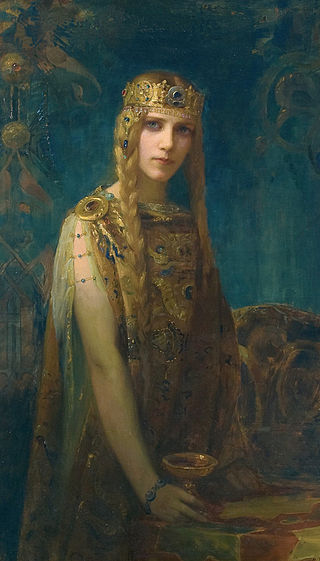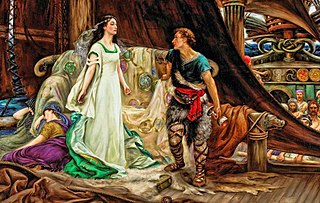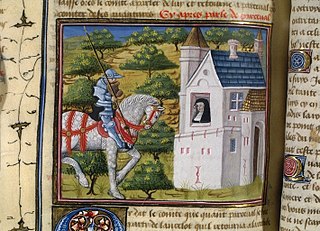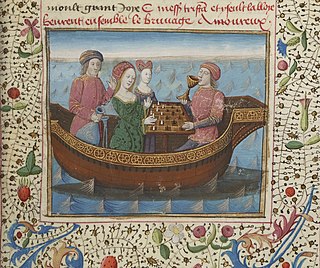Related Research Articles

King Arthur was a legendary Celtic Briton who, according to medieval histories and romances, was leader of the Celtic Britons in battles against Saxon invaders of Britain in the late 5th and early 6th centuries. Details of Arthur's story are mainly composed of Welsh mythology, English folklore and literary invention, and most historians who study the period do not think that he was a historical figure. Arthur is first recorded in sources which date to 300 years after he is supposed to have lived, the Annales Cambriae and the Historia Brittonum. His name also occurs in early poetic sources such as Y Gododdin.

Chrétien de Troyes (ModernFrench: [kʁetjɛ̃ d tʁwa]; Old French: Crestien de Troies[kresˈtjẽn də ˈtrojəs]; was a French poet and trouvère known for his writing on Arthurian subjects, and for first writing of Lancelot, Percival and the Holy Grail. Chrétien's works, including Erec and Enide, Lancelot, Perceval and Yvain, represent some of the best-regarded of medieval literature. His use of structure, particularly in Yvain, has been seen as a step towards the modern novel.
The lais of Marie de France are a series of twelve short narrative Breton lais by the poet Marie de France. They are written in Anglo-Norman and were probably composed in the late 12th century, most likely between 1155-1170. The short, narrative poems generally focus on glorifying the concept of courtly love by the adventures of their main characters. Marie's lais are thought to form the basis for what would eventually become the genre known as the Breton lais. Despite her stature in Anglo-Norman literature and medieval French literature generally, little is known of Marie herself, but it is thought that she was born in France and wrote in England.

Percival, alternatively called Peredur, was one of King Arthur's legendary Knights of the Round Table. First mentioned by the French author Chrétien de Troyes in the tale Perceval, the Story of the Grail, he is best known for being the original hero in the quest for the Grail, before being replaced in later English and French literature by Galahad.

Iseult, alternatively Isolde and other spellings, is the name of several characters in the legend of Tristan and Iseult. The most prominent is Iseult of Ireland, the wife of Mark of Cornwall and the lover of Tristan. Her mother, the queen of Ireland, is also named Iseult. The third is Iseult of the White Hands, the daughter of Hoel of Brittany and the sister of Kahedin.

Mark of Cornwall was a sixth-century King of Kernow (Cornwall), possibly identical with King Conomor. He is best known for his appearance in Arthurian legend as the uncle of Tristan and the husband of Iseult who engages with Tristan in a secret liaison, giving Mark the epithet "Cuckold King".
This is a bibliography of works about King Arthur, his family, his friends or his enemies. This bibliography includes works that are notable or are by notable authors.

The Lancelot-Grail, also known as the Vulgate Cycle or the Pseudo-Map Cycle, is an early 13th-century French Arthurian literary cycle consisting of interconnected prose episodes of chivalric romance in Old French. The cycle of unknown authorship, presenting itself as a chronicle of actual events, retells the legend of King Arthur by focusing on the love affair between Lancelot and Guinevere as well as the religious quest for the Holy Grail, expanding on the works of Robert de Boron and Chrétien de Troyes.

Tristan and Iseult is a medieval chivalric romance told in numerous variations since the 12th century. Based on a Celtic legend and possibly other sources, the tale is a tragedy about the illicit love between the Cornish knight Tristan and the Irish princess Iseult. It depicts Tristan's mission to escort Iseult from Ireland to marry his uncle, King Mark of Cornwall. On the journey, Tristan and Iseult ingest a love potion, instigating a love affair between them.

Perceval, the Story of the Grail is the unfinished fifth verse romance by Chrétien de Troyes, written by him in Old French in the late 12th century. Later authors added 54,000 more lines in what are known collectively as the Four Continuations, as well as other related texts. Perceval is the earliest recorded account of what was to become the Quest for the Holy Grail but describes only a golden grail in the central scene, does not call it "holy" and treats a lance, appearing at the same time, as equally significant.
Cligès is a poem by the medieval French poet Chrétien de Troyes, dating from around 1176. It is the second of his five Arthurian romances; Erec and Enide, Cligès, Yvain, Lancelot and Perceval. The poem tells the story of the knight Cligès and his love for his uncle's wife, Fenice.

The ProseTristan is an adaptation of the Tristan and Iseult story into a long prose romance, and the first to tie the subject entirely into the arc of the Arthurian legend. It was also the first major Arthurian prose cycle commenced after the widely popular Lancelot-Grail, which influenced especially the later portions of the ProseTristan.
Sir Kahedin is brother to Iseult of Brittany and the son of King Hoel of Brittany in Arthurian legend. The story of his affair with Brangaine, the handmaiden of Iseult of Ireland is significantly mentioned in the Tristan and Iseult legend.
Eilhart von Oberge was a German poet of the late 12th century. He is known exclusively through his Middle High German romance Tristrant, the oldest surviving complete version of the Tristan and Iseult story in any language. Tristrant is part of the "common" or "primitive" branch of the legend, best known through Béroul's fragmentary Norman language Tristan. It is German literature's first rendition of the story, though Gottfried von Strassburg's Tristan, part of the "courtly" branch, is more famous and respected.
Brangaine is the handmaid and confidante of Iseult of Ireland in the Arthurian legend of Tristan and Iseult. She appears in most versions of the story.
Brother Robert was a cleric working in Norway who adapted several French literary works into Old Norse during the reign of King Haakon IV of Norway (1217–1263). The most important of these, Tristrams saga ok Ísöndar, based on Thomas of Britain's Tristan, is notable as the only example of Thomas' "courtly branch" of the Tristan and Iseult legend that has survived in its entirety. It was the earliest Scandinavian version of the story, and is thought to be the first Norwegian adaptation of an Old French work. Its success may have inspired the spate of translations during King Haakon's reign.
"Eliduc" is a Breton lai by the medieval poet Marie de France. The twelfth and last poem in the collection known as The Lais of Marie de France, it appears in the manuscript Harley 978 at the British Library. Like the other poems in this collection, "Eliduc" is written in the Anglo-Norman dialect of Old French, in couplets of eight syllables in length. At 1184 lines, it is the longest of the lais attributed to Marie de France. The text of the lai notes that its correct title should be Guildeluec and Guilliadon, but the name Eliduc has stuck.
Strengleikar is a collection of twenty-one Old Norse prose tales based on the Old French Lais of Marie de France. It is one of the literary works commissioned by King Haakon IV of Norway for the Norwegian court, and is counted among the Old Norse Chivalric sagas. The collection is anonymous. It has been attributed to Brother Robert, a cleric who adapted several French works into Norse under Haakon, the best known of which is Tristrams saga ok Ísöndar, but there is also reason to think that the collection may be a gathering of the work of several different translators. Unlike many medieval translations, the Strengleikar are generally extremely close in sense to the Old French originals; the text which differs most is Milun, which is abridged to half its original length.
The Folie Tristan d’Oxford, also known as the Oxford Folie Tristan, The Madness of Tristan, or Tristan’s Madness, is a poem in 998 octosyllabic lines written in Anglo-Norman, the form of the Norman language spoken in England. It retells an episode from the Tristan legend in which Tristan disguises himself as a madman to win his way back to Ysolt. The poem can be dated to the period 1175–1200, but the name of the author is unknown. It is not to be confused with the Folie Tristan de Berne, a different medieval poem on the same subject, each work taking its name from the city in which the manuscript is now kept.

The Old French Tristan Poems: A Bibliographic Guide is a 1980 bibliography by David J. Shirt, a scholar of French literature who specialised in Arthurian and Tristan studies. It presents an overview of the literature on the medieval Tristan and Iseult poems, including the 12th-century poems by Béroul and Thomas of Britain. The book was published by Grant & Cutler as volume 28 of the Research Bibliographies and Checklists series. Critics generally praised its layout and use of cross-references, though some pointed out studies that the bibliography omitted. Reviewers also applauded Shirt's inclusion of a verse-by-verse index of Béroul's text.
References
- Burgess, Glyn S. The Lais of Marie de France. Athens. The University of Georgia Press, 1987.
- Chrétien de Troyes; Bryant, Nigel (translator) (1996). Perceval, the Story of the Grail. Cambridge: D. S. Brewer. ISBN 0-85991-224-8.
- Lacy, Norris J. (Ed.) (1991). The New Arthurian Encyclopedia. New York: Garland. ISBN 0-8240-4377-4.
- Marie de France; Busby, Keith (translator) (2003). The Lais of Marie de France. New York: Penguin ISBN 0-14-044759-8
- Whalen, Logan E. Marie de France & The Poetics of Memory. Washington, D.C. The Catholic University of America Press. 2008.